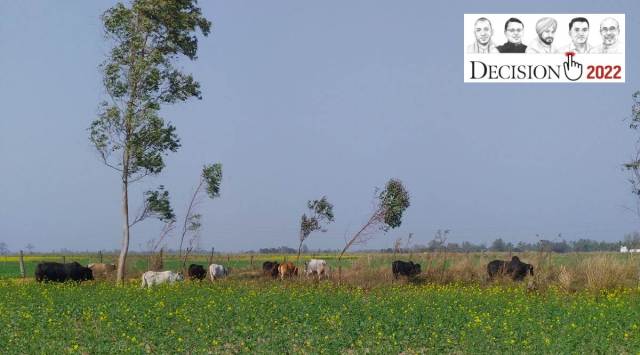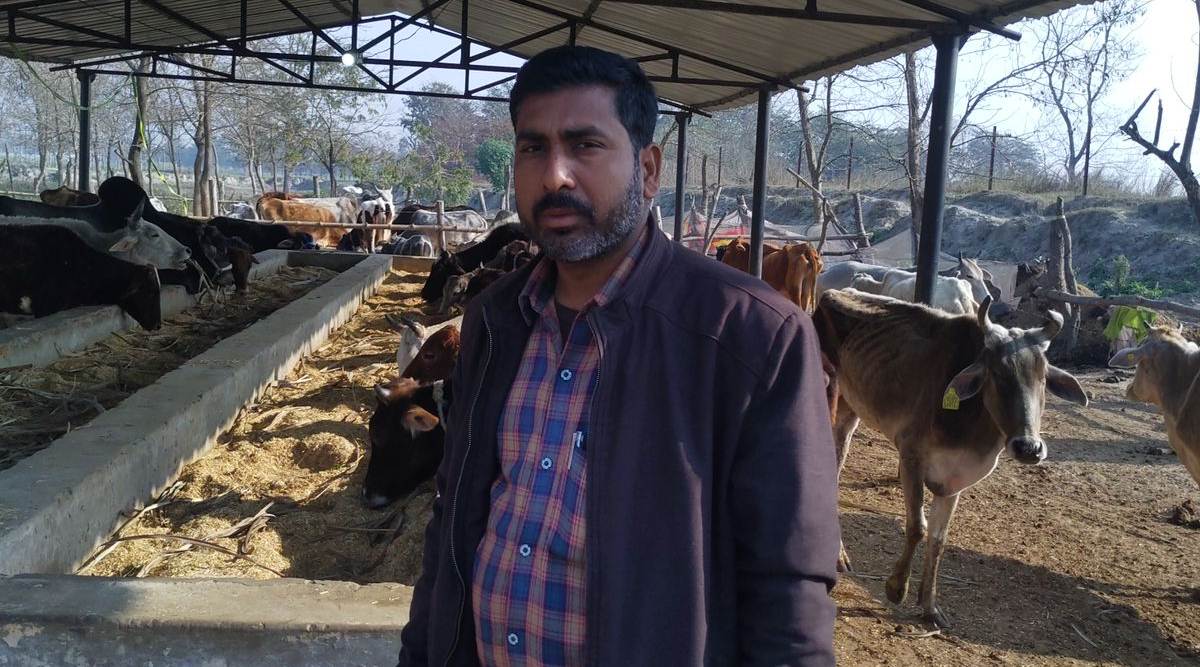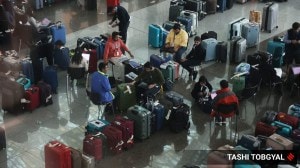The reason is simple: West UP is predominantly a buffalo belt, whereas the population of cattle – the cow and its progeny – rises as one goes east. Thus, buffalo numbers in Agra (10.67 lakh), Bulandshahr (9.72 lakh) and Aligarh (9.42 lakh), as per the Livestock Census for 2019, far exceeded that of cattle – at 2.83 lakh, 3.04 lakh and 3.11 lakh, respectively – for these three districts. It’s the other way round, with more cattle than buffaloes, in Gorakhpur (2.87 lakh versus 2.53 lakh), Deoria (2.88 lakh vs. 1.91 lakh) and Mirzapur (5.11 lakh vs. 2.88 lakh).

The effects of cattle slaughter ban – its strict enforcement by the Yogi Adityanath-led BJP government – are clearly seen on the ground.
 Farmer Pankaj Yadav (right), who has barbed wire-fenced his field at Durauni village in Gonda. (Express photo by Harish Damodaran)
Farmer Pankaj Yadav (right), who has barbed wire-fenced his field at Durauni village in Gonda. (Express photo by Harish Damodaran)
According to Ramchandra Tripathi, a farmer from Basevarai in Harraiya tehsil of Basti district, stray cattle were non-existent in his village five years ago. “Today, we have 50-60 saand (bulls),” says the 57-year-old who grows sugarcane on 50, wheat on 22, mustard on 18 and assorted vegetables and fodder on the rest of his 100-bigha (20 acres) holding. The Indian Express alone counted a dozen animals devouring the standing mustard in a nearby field.
“They have destroyed my wheat in 3 out of 5 bigha,” complains Shiv Prasad Verma, who also farms mustard on another 3 and sugarcane on 2 bigha. “Five years ago, we all chanted gau hatya band karo (stop cow slaughter) and voted for BJP both in 2017 (UP Assembly elections) and 2019 (for Lok Sabha). But this time, we are fully behind Triyambak Nath Pathak (Samajwadi Party candidate from Harraiya). The only reason is awara pashu,” states Sudhir Kumar Tiwari (25), who cultivates wheat on 10, cane on 5, mustard on 3 and masoor (lentil) on 2 of his total 20 bigha.
Crop damage by stray cattle wasn’t a major problem in the pre-Yogi government period, as the ban on slaughter was largely on paper. But as the number of strays – bulls, male calves and non-milking cows let loose by farmers themselves – have multiplied over time, its political fallout could well be more in the eastern ‘cow’ than the western ‘buffalo’ belt. An indicator of that was Prime Minister Narendra Modi’s BJP rally speech at Unnao on Sunday, in which he promised a new policy to address “chutta jaanvaron se pareshani (stray animal trouble)” after March 10, when the results of the ongoing polls are out.

For farmers, the costs are not only on account of crop loss, but also erecting barbed wire fences around fields to prevent entry of animals. “For a single bigha (0.2 acres), 100 kg of steel wire at Rs 80-90/kg and 40 RCC poles (costing Rs 200-250/pole) are required for three rounds. That comes to over Rs 16,000,” points out Jagnarayan Verma, pradhan (president) of Basevarai panchayat.
Story continues below this ad
But it isn’t just Basti. Similar anger is palpable in neighbouring districts. “Without awara pashu, my wheat yields would be 4 quintals per bigha. But now I’ll be happy to even harvest 2 quintals,” notes Ram Sundar Yadav, standing guard over his 4 bigha of wheat and one bigha of mustard at Durauni village in Gonda district’s Colonelganj tehsil. Both he and fellow villager Pankaj Yadav, who has fenced his 16-bigha holding, claim they voted for BJP in the last two elections. This time, they are supporting SP’s Yogesh Pratap Singh: “Baila hi mudda hai (bull is the only issue)”.
 Ashwini Kumar Tiwari, operator of a gaushala housing 92 animals at Maijapur in Gonda district. (Express photo by Harish Damodaran)
Ashwini Kumar Tiwari, operator of a gaushala housing 92 animals at Maijapur in Gonda district. (Express photo by Harish Damodaran)
While the Yogi government’s answer to the stray cattle menace has been to help build more gaushalas (cow shelters), farmers aren’t too impressed. “If I take my animal there, they will straightaway demand Rs 2,000 from me. They also loot the government by taking money and not properly feeding the animals,” avers Shesh Narayan Paswan, a 10-bigha sugarcane, wheat and mustard grower from Shree Jot village of Colonelganj.
The UP government is paying Rs 30 a day for every animal housed in gaushalas. The Gau Ashray Kendra at Maijapur in Colonelganj, which was opened in August 2020, has 57 female and 45 male cattle. An average animal, even if unproductive, needs to be given about 5 kg of bhusa (wheat straw) and 1 kg of either whole flour, cattlefeed, rice polish or mustard oilcake. The delivered cost of bhusa and polish is currently around Rs 16/kg, while Rs 22 for flour, Rs 24 for cattlefeed and Rs 40-42 for oilcake.
“The Rs 30/day/animal provision cannot cover even the requirement of bhusa, including in the April-July period after harvesting when prices fall to Rs 7.5-8/kg,” admits Ashwini Kumar Tiwari, whose wife Rekha is the pradhan of the Maijapur gram panchayat that runs the gaushala catering to 12 villages in the area. “Our monthly expenditure is over Rs 1.5 lakh. We get hardly half of it from the government and even that comes with up to six months delay,” he adds.
Story continues below this ad
Surya Prasad Shukla, a progressive farmer and nursery owner from Maijapur, feels that the government shouldn’t “waste money” in gaushalas: “They should build schools, hospitals and village roads rather than gaushalas. These cannot, in any case, handle big bulls that are the real problem. The government can give subsidy to groups of, say, 10 farmers to enable them to barricade their fields”.



 Farmer Pankaj Yadav (right), who has barbed wire-fenced his field at Durauni village in Gonda. (Express photo by Harish Damodaran)
Farmer Pankaj Yadav (right), who has barbed wire-fenced his field at Durauni village in Gonda. (Express photo by Harish Damodaran)
 Ashwini Kumar Tiwari, operator of a gaushala housing 92 animals at Maijapur in Gonda district. (Express photo by Harish Damodaran)
Ashwini Kumar Tiwari, operator of a gaushala housing 92 animals at Maijapur in Gonda district. (Express photo by Harish Damodaran)





























